What Is Pika?
Section titled “What Is Pika?”Pika is an open-source AWS agentic framework that delivers production-ready AI chat applications. Deploy complete chat experiences - front and back end - for your internal teams or customers.
Create Chat Apps for Any Audience
Build chat applications backed by AI agents. Serve authenticated internal users, external customers, or both.
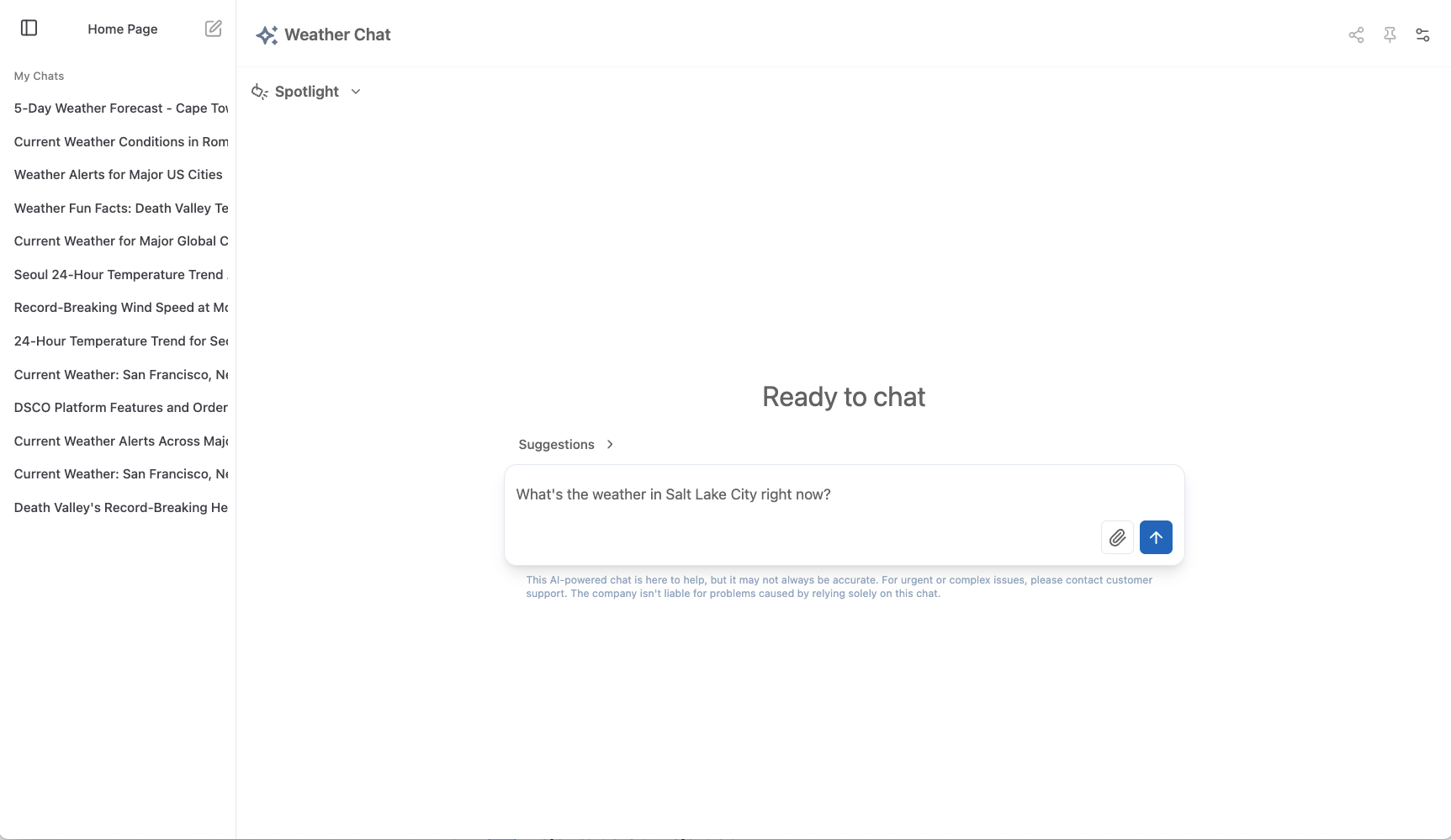
Complete Front and Back End
Get a full-featured chat experience out of the box. Professional UI, streaming responses, session management, and enterprise security included.

Extensible UI with Web Components
Customize the interface with web components that have direct AI access. Build rich, interactive experiences like the Spotlight section shown here.
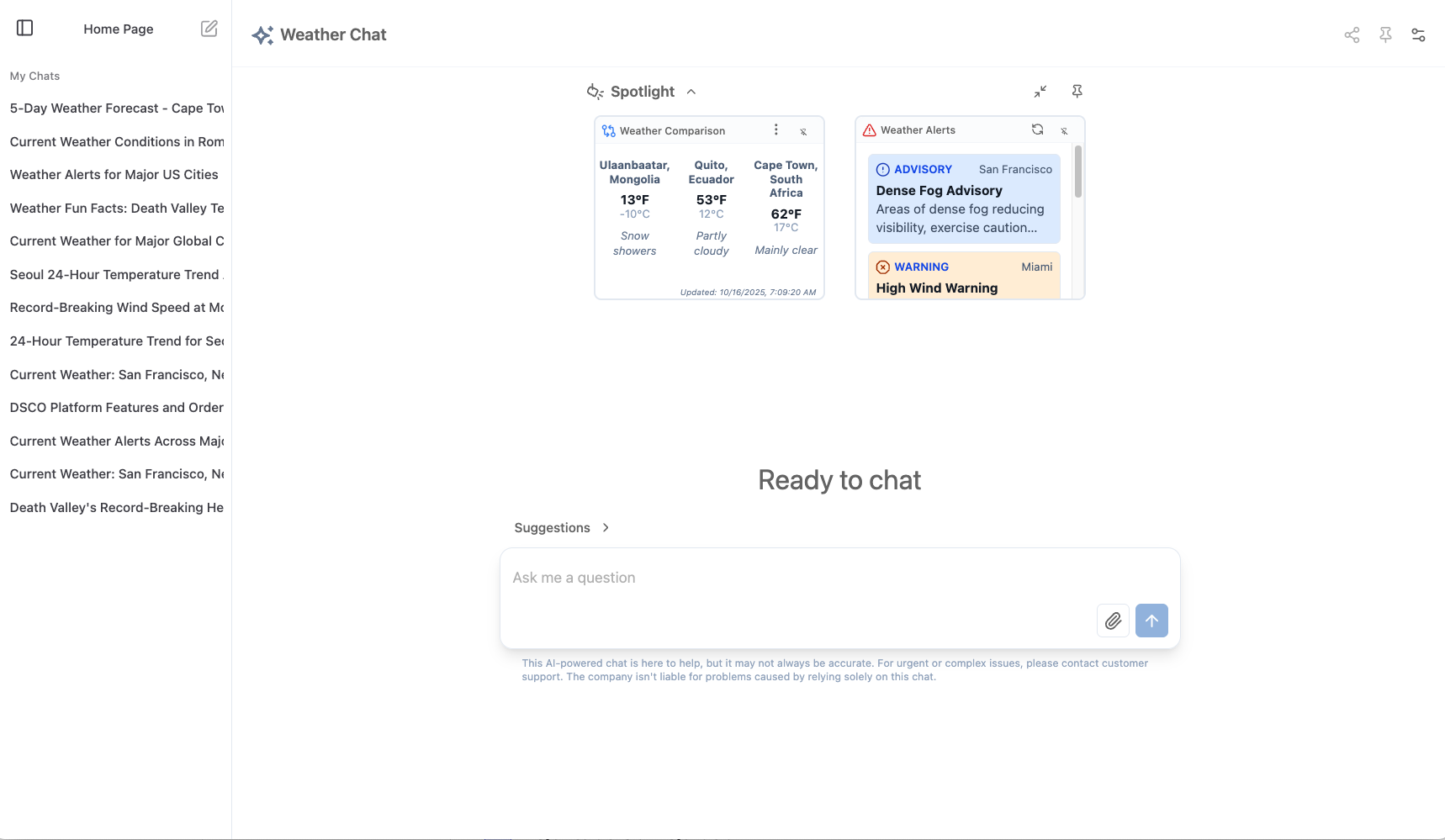
Multiple Independent Chat Apps
Define multiple chat apps on one deployment. Each has its own audience - internal only, customers only, or both.
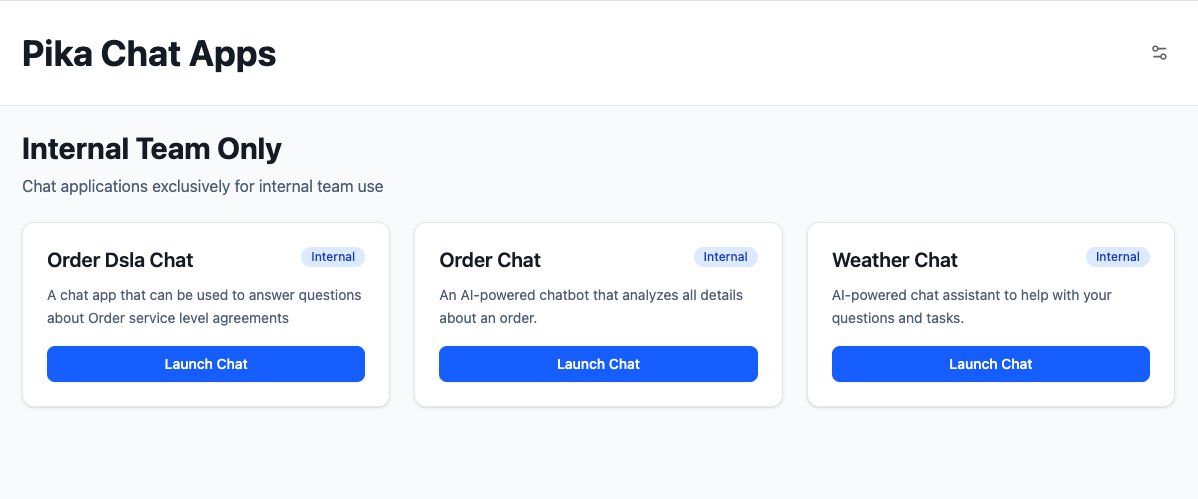
Transparent AI Reasoning
Answers stream with AI reasoning visible to developers and admins. See exactly what the agent did and why.
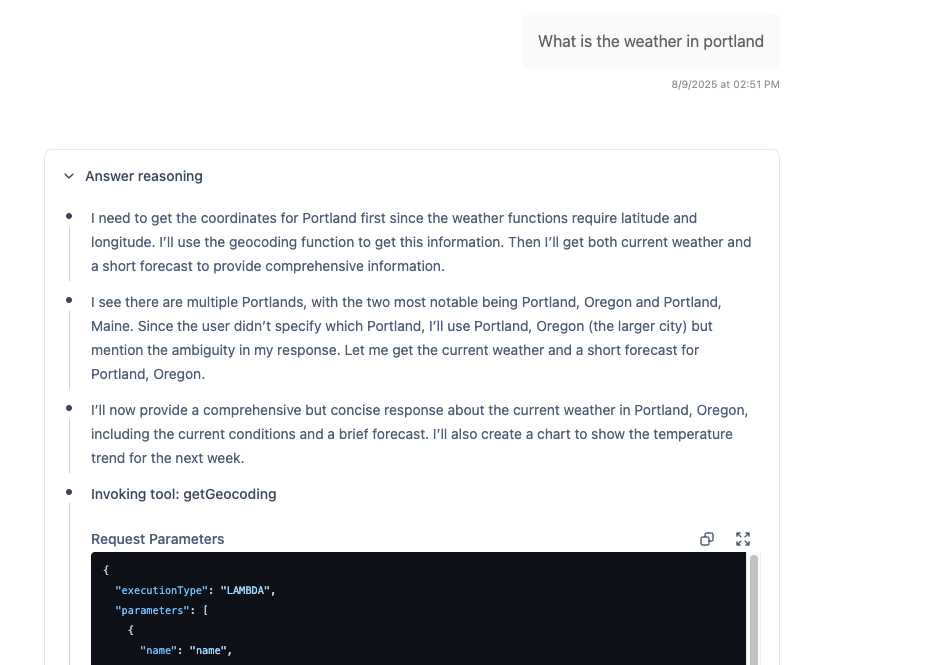
Self-Grading Responses
The AI evaluates its own answers. Show grades to internal teams, external users, both, or neither - you control visibility.

Built-In Administration
A complete admin site comes with Pika. Manage your deployment without building administrative tools.
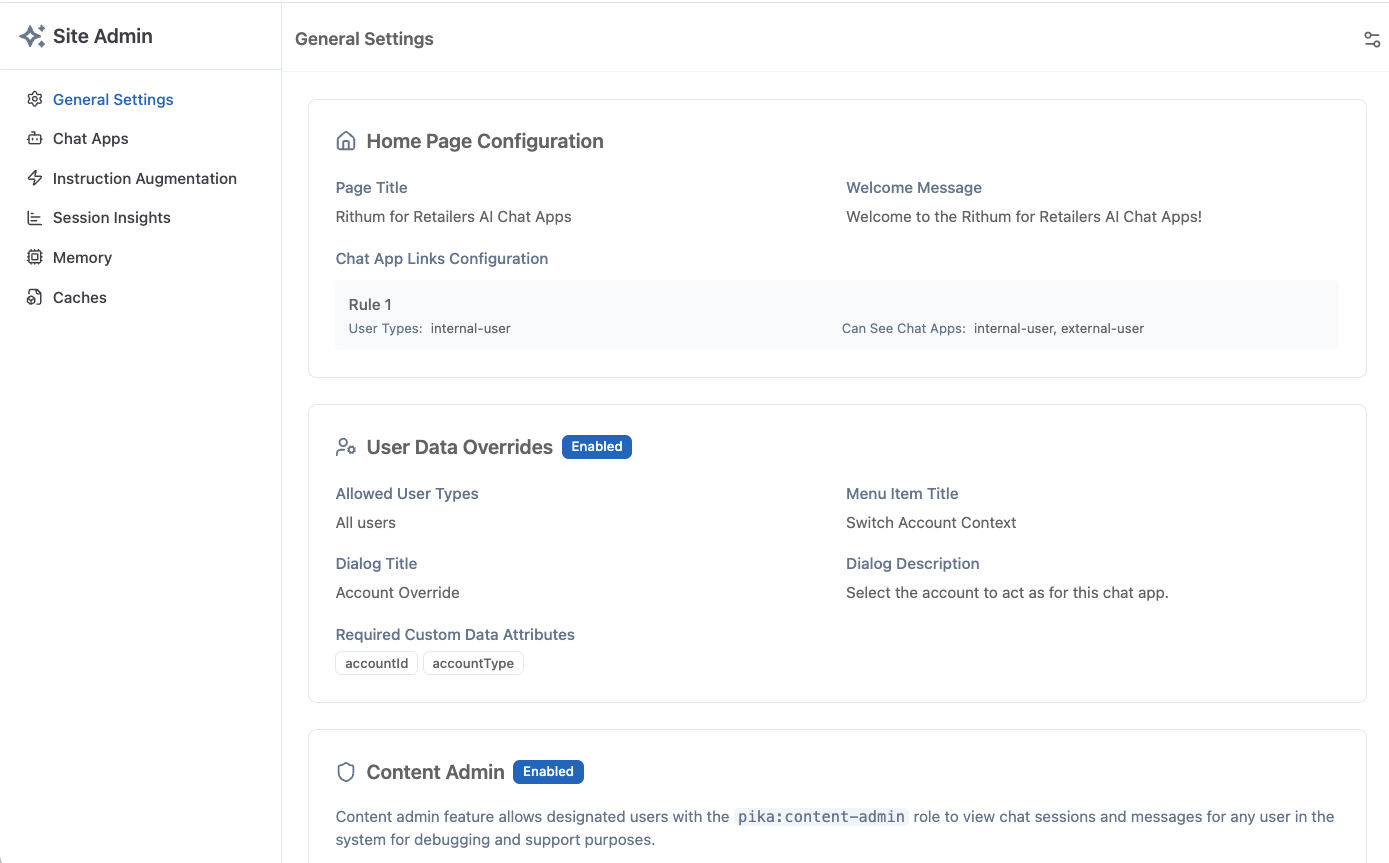
Per-App Control
Configure each chat app independently. Control access, features, and behavior for different audiences.
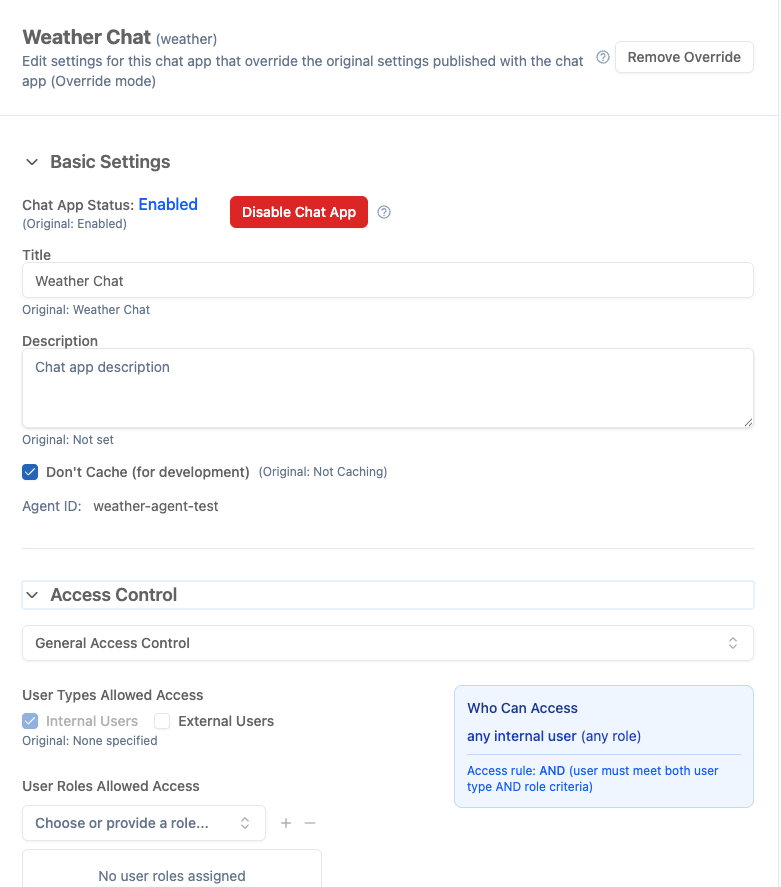
Review All Interactions
Browse and search every user conversation. Debug issues, gather insights, and understand usage patterns.
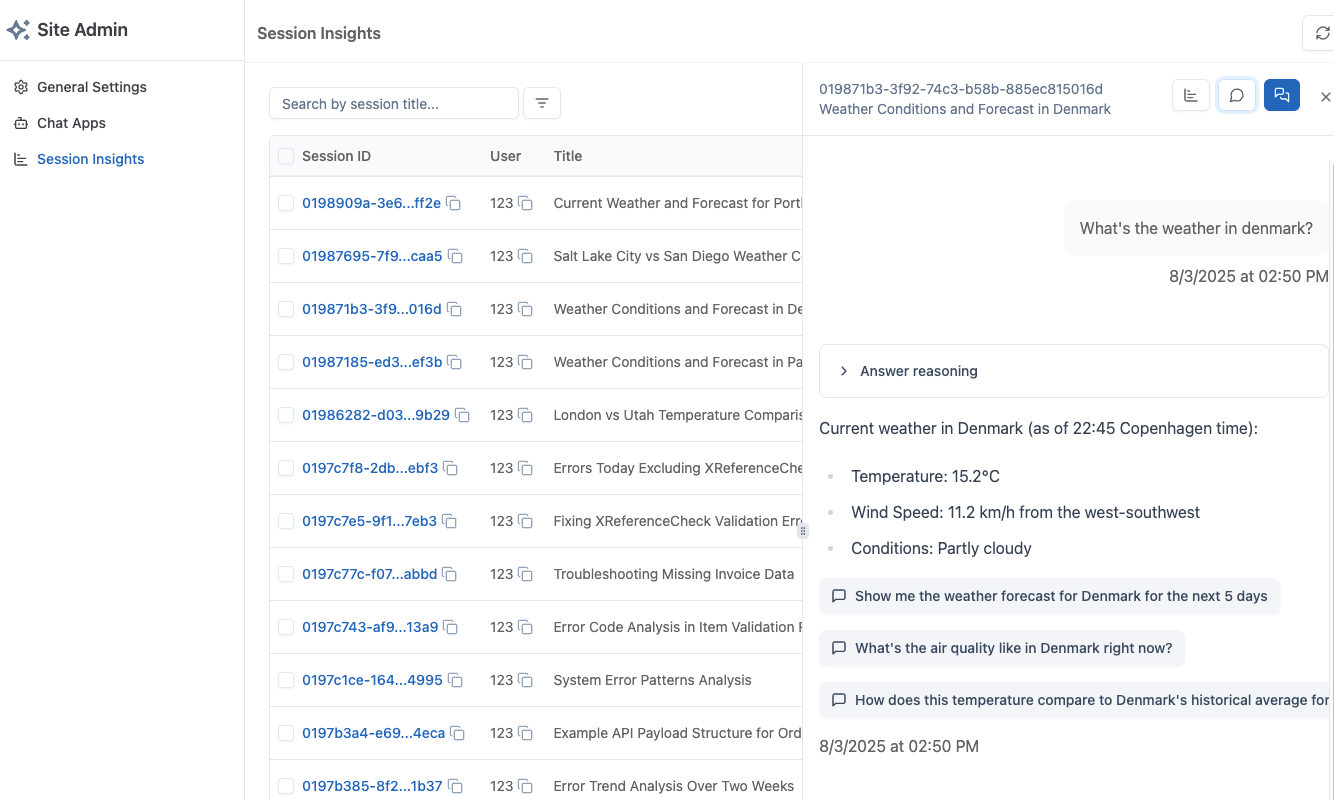
Automatic Insights
The system generates insights for every conversation. Track metrics, sentiment, goal completion, and quality automatically.

AI and Human Feedback
A separate AI analyzes conversations and generates improvement feedback. Collect human feedback too - all in one system.
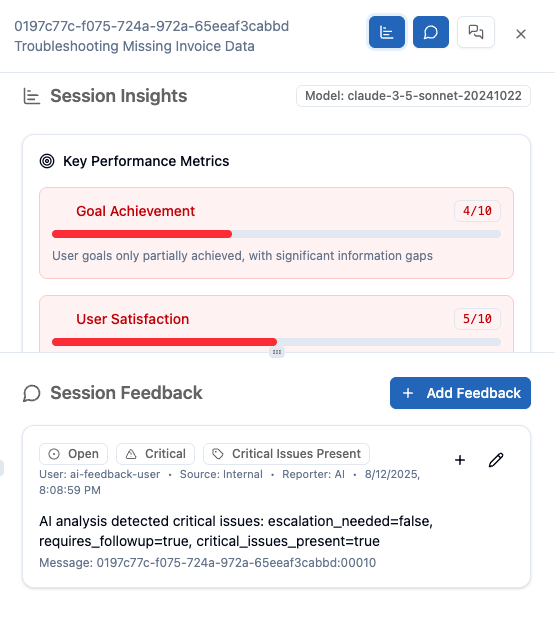
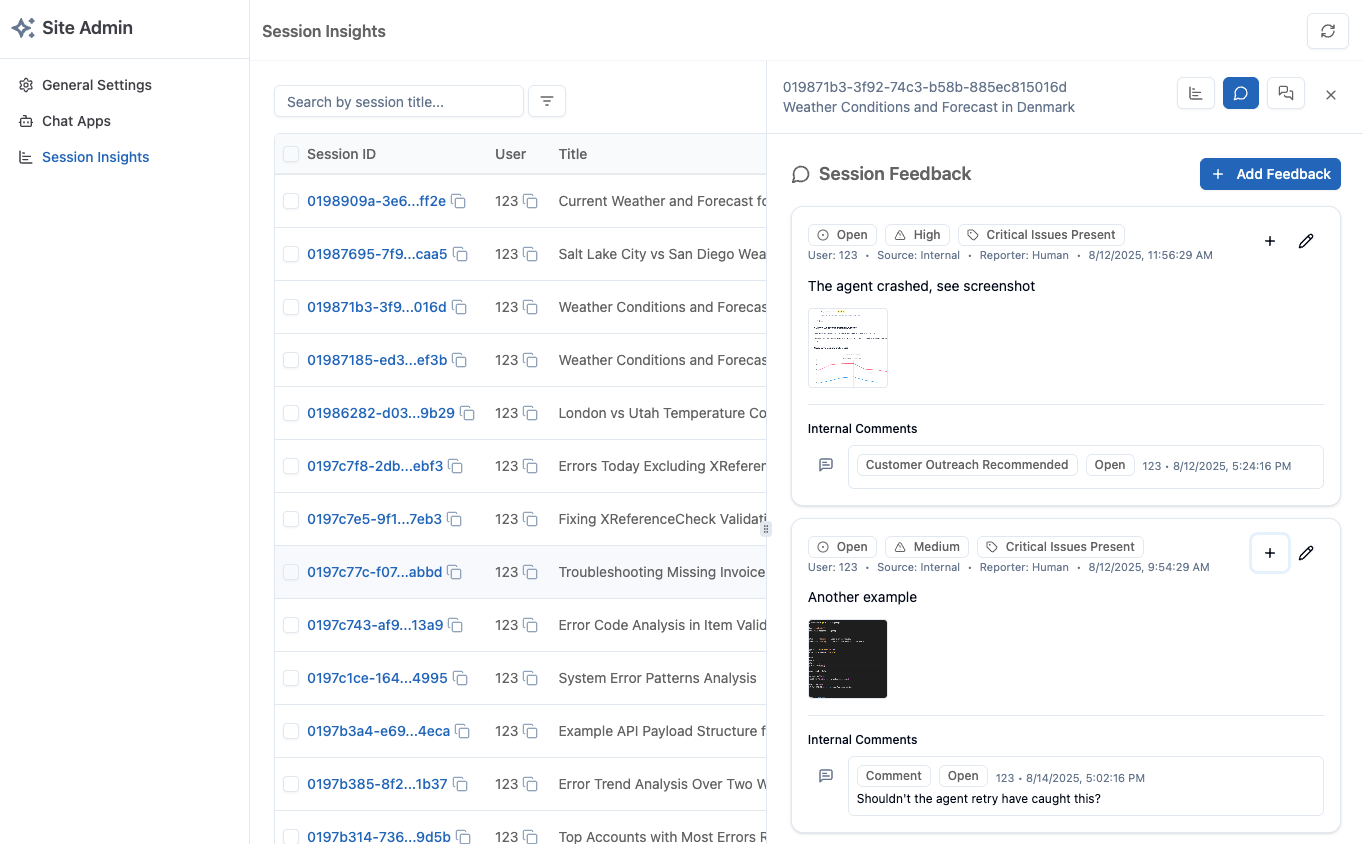
Dedicated URLs with Enterprise Auth
Each chat app gets its own URL. Your enterprise authentication controls access.


The bottom line: Pika delivers everything between your idea for an AI assistant and a production system your users rely on. Built exclusively on AWS for scale, security, and operational simplicity.
The AI Integration Challenge
Section titled “The AI Integration Challenge”Building a demo AI agent is quick. Building one your customers can actually use takes significantly longer.
The gap between prototype and production is filled with challenges most teams underestimate:
Beyond the Shiny Demo
Section titled “Beyond the Shiny Demo”Your developers will build an agent quickly using modern agentic frameworks. They'll connect it to a database, show you a chat interface, and it will look amazing. You'll be excited about the possibilities.
Then your users try it.
The Problems You'll Face
Section titled “The Problems You'll Face”Getting from that shiny demo to a reliable product requires solving:
- Security & Authentication: Integrating your enterprise SSO, managing user types, handling multi-tenancy, and protecting sensitive data
- Session Management: Persisting conversations, managing context, organizing chat history, and enabling collaboration
- UI & UX: Building a professional chat interface with all expected features - file upload, code formatting, streaming responses, mobile support
- Scalability: Handling traffic spikes, managing costs, optimizing response times, and ensuring availability
- Observability: Tracking usage, debugging failures, analyzing conversation quality, and measuring success
- Iteration & Improvement: Identifying edge cases, gathering feedback, refining prompts, and deploying updates safely
These aren't nice-to-haves. They're the difference between a toy and a tool.
Why Not Just Build It Yourself?
Section titled “Why Not Just Build It Yourself?”You absolutely can build this yourself. Many teams do. But understand what you're signing up for.
The True Cost of Custom Development
Section titled “The True Cost of Custom Development”What you'll build:
- Chat session storage and retrieval
- Message persistence with streaming
- User authentication integration
- Real-time WebSocket connections
- API Gateway configuration
- Lambda function orchestration
- DynamoDB schema design
- S3 integration for files
- CloudWatch logging and monitoring
What you'll build:
- Complete chat interface
- Message rendering with formatting
- Code syntax highlighting
- Streaming message display
- File upload handling
- Session list and search
- Mobile responsiveness
- Accessibility compliance
- Dark mode support
What you'll build:
- Enterprise SSO integration
- Session token management
- Access control system
- Multi-tenancy isolation
- Audit logging
- Data encryption
- Compliance controls
- Security testing
What you'll build:
- Deployment pipelines
- Infrastructure as Code
- Monitoring and alerting
- Cost tracking
- Performance optimization
- Error handling and recovery
- Backup and disaster recovery
- Documentation
The Alternative
Section titled “The Alternative”Pika provides all of this out of the box. You deploy it once, configure your authentication, define your agents as config, and start focusing on what makes your agents valuable to users.
The Pika Approach
Section titled “The Pika Approach”Pika is built on three core principles that make production AI applications achievable.
Explore The Pika Approach in depth →
AWS Foundation: Scale Without the Complexity
Section titled “AWS Foundation: Scale Without the Complexity”We use AWS because it solves the hard infrastructure problems for you.
When you deploy Pika, you get:
- Amazon Bedrock for AI capabilities with leading models (Claude, etc.)
- AWS Lambda for serverless compute that scales automatically
- DynamoDB for session storage with single-digit millisecond latency
- API Gateway for robust REST APIs
- OpenSearch for indexed sessions and analytics
- EventBridge for background job orchestration
This isn't just about convenience. It's about production-grade infrastructure that:
- Handles traffic spikes automatically
- Scales to millions of users
- Provides 99.9%+ uptime SLAs
- Maintains SOC 2, ISO 27001, HIPAA compliance
- Offers clear cost models with pay-per-use pricing
Agent-as-Config: Your Business Intelligence, Protected
Section titled “Agent-as-Config: Your Business Intelligence, Protected”Most agent frameworks make you code within their codebase. Pika takes a different approach.
Your agents, tools, and chat apps are defined as configuration deployed from your existing microservices. This strategic approach means:
Define Where You Have Access
Your microservices already have database access, file access, and business logic libraries. Define agent tools right there - where you already have what you need.
Your AI IP Is Protected
Your investment isn't in using an agentic framework - it's in the business intelligence you expose through agents. All agent definitions, tools, and prompts become configuration in Pika's database: this IS your organizational AI IP.
Decentralized Definition, Centralized Access
Teams define agents and tools in their own stacks where the business logic lives. But everything is accessible through a centralized UI and database for governance and reuse.
This architectural decision has profound implications:
- Natural Tool Development: Create tools where you already have access to data and APIs
- Protected Investment: Your AI IP (agents, prompts, tools) lives as config, independent of any framework
- Team Independence: Each team defines their agents, but organization-wide visibility and reuse
- Safe Evolution: Change agent behavior via configuration updates, not infrastructure changes
Learn more about Agents-as-Config →
Production-Ready from Day One
Section titled “Production-Ready from Day One”Pika includes everything needed for production deployment:
Complete UI
Section titled “Complete UI”A world-class chat interface that works standalone or embedded in your existing applications:
- Professional message formatting with syntax highlighting
- Streaming responses with visual feedback
- File upload with preview
- Session history and search
- Pinning and sharing
- Mobile-responsive design
- Accessibility compliant
Enterprise Security
Section titled “Enterprise Security”Production security without the work:
- Pluggable authentication (integrate your SSO/SAML/OAuth)
- User type management (internal vs external)
- Entity-based access control (multi-tenancy)
- Role-based permissions
- Audit logging
- Secure session management
Operational Tooling
Section titled “Operational Tooling”The features you need to run AI in production:
- Self-correcting responses: Independent LLM verification catches errors
- LLM-generated feedback: Automatic analysis of conversation quality
- AI-driven insights: Session metrics, sentiment, goal completion
- Detailed traces: Debug exactly what agents did and why
- Admin interface: Manage apps, users, and access controls
Learn more about Production-Ready features →
From Toy to Tool: The Missing Middle
Section titled “From Toy to Tool: The Missing Middle”This is where Pika truly differentiates itself. Getting an agent to work isn't hard. Getting it to work reliably for real users is.
Pika provides the capabilities that bridge this gap:
Self-Correcting Loop
An independent LLM evaluates agent responses and can trigger automatic reprompting if quality is insufficient. Catch mistakes before users see them.
Continuous Learning
LLM-generated feedback analyzes completed sessions to identify patterns, edge cases, and improvement opportunities. Understand what's working and what's not.
Rapid Iteration
Instruction assistance and augmentation features help you refine agent behavior quickly based on real usage patterns.
User Memory
Persistent user context across all sessions means agents get better at personalizing responses over time.
Who Is Pika For?
Section titled “Who Is Pika For?”Pika is designed for teams building production AI applications. While it provides enterprise-grade capabilities, it's built to be approachable whether you're at a startup or a large organization.
For Product Teams
Section titled “For Product Teams”Your Challenge: You need AI features that delight users without becoming a science project.
How Pika Helps:
- Ship AI features rapidly
- Professional UI that matches modern expectations
- Analytics to understand what users are actually doing
- Rapid iteration based on real usage patterns
- Confidence that it will scale when users show up
For Engineering Teams
Section titled “For Engineering Teams”Your Challenge: Build AI capabilities without derailing your roadmap or creating maintenance nightmares.
How Pika Helps:
- Deploy via familiar AWS CDK/CloudFormation workflows
- Agents as config - no special deployment process
- Clean separation from your core codebase
- Observable, debuggable, and maintainable
- AWS-native so it fits your existing infrastructure
For Organizations of All Sizes
Section titled “For Organizations of All Sizes”Your Challenge: Deploy AI for both internal tools and customer-facing applications with appropriate security and governance.
How Pika Helps:
- Multi-tenancy built in: Support multiple organizations on one deployment
- Flexible access controls: Internal vs external users, role-based permissions, entity isolation
- Compliance ready: Audit trails, data protection, no AI training on your data
- Scalable architecture: Start small, grow as needed
- Cost effective: Serverless pricing means you only pay for what you use
The platform handles both internal employee tools and customer-facing applications with the same deployment, but with fine-grained control over who sees what.
When to Choose Pika
Section titled “When to Choose Pika”Pika is the right choice when:
You're Building on AWS
Pika is AWS-only by design. If you're already on AWS or planning to be, Pika leverages services you already understand and trust.
You Need Production Quality
If you're building something users will depend on (not just experimenting), Pika provides the observability, reliability, and security production systems require.
You Want Clean Architecture
If you value separation of concerns and don't want agent code tangled with your business logic, Pika's config-based approach keeps boundaries clear.
You Need Multiple Use Cases
If you're planning multiple chat applications or agents, Pika's platform approach means you build the infrastructure once and deploy many agents.
When Pika Might Not Fit
Section titled “When Pika Might Not Fit”Pika is not the right choice if:
- You need to run on platforms other than AWS
- You're building a highly specialized agent framework with unique requirements
- You prefer managing every aspect of the infrastructure yourself
- You only need a simple chatbot without advanced features
Comparison Matrix
Section titled “Comparison Matrix”How does Pika compare to other approaches for building AI agent applications?
Pika vs. Building Custom on AWS
Section titled “Pika vs. Building Custom on AWS”| Dimension | Pika | Custom AWS Build |
|---|---|---|
| Time to Production | Days - deploy complete application with agents | Months - build infrastructure, UI, security, monitoring |
| Infrastructure | Complete: Lambda, DynamoDB, OpenSearch, Bedrock, auth, session management | You build everything from scratch |
| UI/UX | Production-ready chat interface with streaming, web components, admin site | Build your own frontend and admin tools |
| Security | Built-in authentication integration, access control, multi-tenancy | Implement security layer yourself |
| Operational Tools | Admin site, traces, monitoring, LLM feedback, insights included | Build your own operational tooling |
| Cost Structure | AWS infrastructure costs only (pay for what you use) | AWS costs + months of development time |
| Learning Curve | Learn Pika's config-based approach | Learn all AWS services + build integration |
| Flexibility | Configure within framework patterns | Complete control but complete responsibility |
Best For
Pika: Teams who want production-ready AI apps quickly without building infrastructure.
Custom AWS: Organizations with unique requirements that don't fit any framework, or those with extensive AWS expertise and specific architectural needs.
Pika vs. LangChain/LlamaIndex + Custom UI
Section titled “Pika vs. LangChain/LlamaIndex + Custom UI”| Dimension | Pika | LangChain/LlamaIndex + UI |
|---|---|---|
| Time to Production | Days - complete platform ready to deploy | Weeks - integrate agent framework with custom UI and infrastructure |
| Infrastructure | Complete AWS stack with deployment automation | Choose and configure your own infrastructure |
| UI/UX | Production chat interface with streaming, admin site, web components | Build entire frontend from scratch |
| Security | Authentication, authorization, multi-tenancy built-in | Implement security, auth, access control yourself |
| Operational Tools | Traces, monitoring, feedback, insights, admin interface included | Build your own operational and admin tools |
| Cost Structure | AWS infrastructure costs | Infrastructure costs + frontend development time |
| Learning Curve | Learn Pika's agent-as-config approach | Learn LangChain/LlamaIndex + implement UI + setup infrastructure |
| Flexibility | Opinionated AWS + Svelte stack | Choose any infrastructure and frontend stack |
Best For
Pika: Teams who want a complete platform with UI and operational tools included.
LangChain/LlamaIndex: Teams who need flexibility in infrastructure choice or have existing UI frameworks, and have time to build the complete application layer.
Pika vs. Commercial Agent Platforms
Section titled “Pika vs. Commercial Agent Platforms”| Dimension | Pika | Commercial Platforms |
|---|---|---|
| Time to Production | Days - deploy to your AWS account | Varies - typically fast but vendor-dependent |
| Infrastructure | Deploy in your AWS account - you own and control everything | Vendor-managed infrastructure - less control |
| UI/UX | Included, customizable with web components | Varies - often limited customization |
| Security | Your AWS account, your security controls, your compliance | Trust vendor security, limited control over compliance |
| Operational Tools | Admin site, traces, insights - all included | Vendor-provided dashboards - limited customization |
| Cost Structure | Infrastructure costs only - no per-user or per-message fees | Monthly/annual fees + usage fees + seat licensing |
| Learning Curve | Learn Pika framework and config approach | Learn vendor platform and limitations |
| Flexibility | Full access to code, extend as needed, deploy anywhere | Limited by vendor capabilities and APIs |
Best For
Pika: Organizations that need data sovereignty, want to avoid vendor lock-in, or require control over their infrastructure and costs.
Commercial Platforms: Teams who prefer managed services, don't have AWS expertise, or need enterprise support contracts.
Pika vs. Other Open-Source Agent Frameworks
Section titled “Pika vs. Other Open-Source Agent Frameworks”| Dimension | Pika | Other Frameworks |
|---|---|---|
| Time to Production | Days - includes UI, infrastructure, deployment | Varies - typically focused on agent logic only |
| Infrastructure | Complete AWS stack with CDK deployment automation | Usually just agent runtime - you add infrastructure |
| UI/UX | Production chat interface with admin site included | Most don't include UI - you build it |
| Security | Authentication, access control, multi-tenancy ready | Varies - often need to add security layer |
| Operational Tools | Admin site, traces, monitoring, insights built-in | Usually limited - you add operational tooling |
| Cost Structure | AWS infrastructure costs | Depends on infrastructure you choose |
| Learning Curve | Learn Pika's config-based, AWS-centric approach | Varies by framework - often more code-heavy |
| Flexibility | Opinionated AWS + agent-as-config pattern | Varies - some more flexible, some more opinionated |
Best For
Pika: Teams who want a complete, production-ready platform with UI and operations included, and are comfortable with AWS.
Other Frameworks: Teams with specific agent orchestration needs, those avoiding vendor lock-in to cloud providers, or developers who prefer to assemble their own stack.
Key Decision Factors
Section titled “Key Decision Factors”Consider Pika when:
- You're on AWS - Pika is built for AWS and leverages managed services for scale
- You need UI included - Production chat interface and admin tools come ready
- Time to market matters - Deploy complete applications in days, not months
- You want operational visibility - Traces, monitoring, and insights are built-in
- Cost predictability - Pay only for AWS infrastructure, no per-user fees
- Data sovereignty required - Everything runs in your AWS account
Consider alternatives when:
- Multi-cloud required - Pika is AWS-specific
- Maximum flexibility needed - Building custom gives complete control
- Existing infrastructure - You have non-AWS infrastructure you must use
- Managed service preference - You prefer vendor-managed platforms
- Different agent patterns - Your agent orchestration needs don't fit Pika's model
Next Steps
Section titled “Next Steps”Ready to see Pika in action?
Quick Start
Deploy your first agent in 15 minutes with our quick start guide.
Explore Capabilities
Learn what Pika can do with detailed capability documentation.
Coming soon
Read the Concepts
Understand how Pika works and the thinking behind key design decisions.
The question isn't whether you can build production AI applications. It's whether you want to spend significant time building infrastructure or focus on building intelligence.
Pika handles the former so you can focus on the latter.
